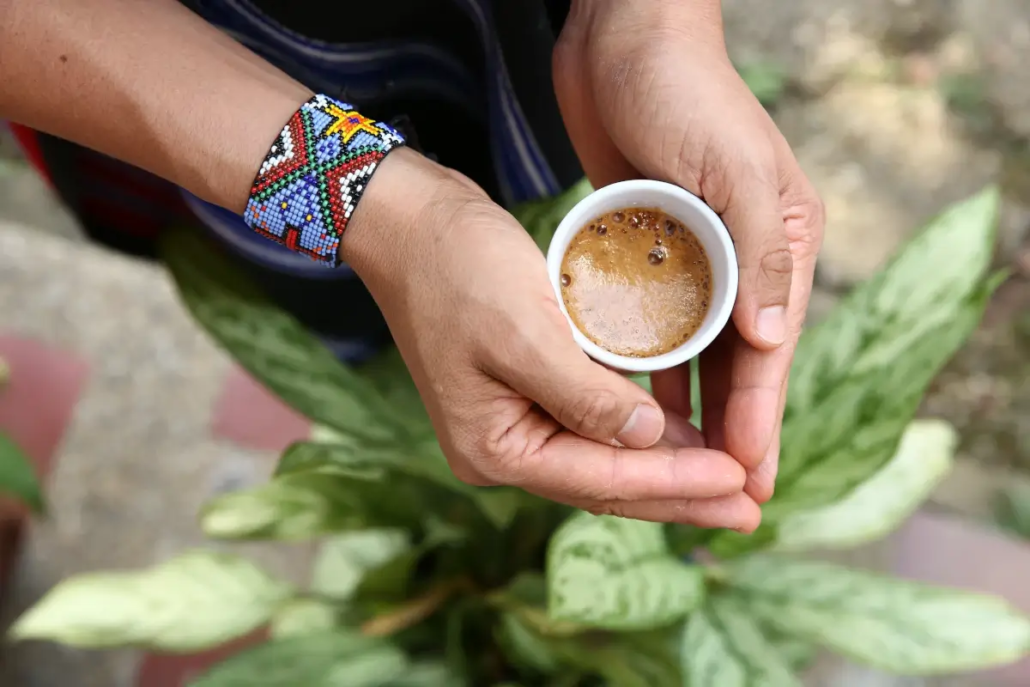The potential of Ayahuasca as an antidepressant
Ayahuasca is a traditional South American tea that has been used in spiritual ceremonies for centuries. But it could play a groundbreaking role in modern mental health. Why? The answer lies in its potential effects as an antidepressant.
Ayahuasca and depression
Research shows that Ayahuasca can improve depressive symptoms. Consumption of this drink leads to changes in neurotrophic factors such as BDNF (Brain-Derived Neurotrophic Factor). Neurotrophic factors are proteins that support the growth, survival and differentiation of neurons in the brain. They play a crucial role in neuroplasticity, the process by which the brain can change and adapt itself. BDNF is particularly important for learning and memory and is often linked to brain health in research. Low levels of BDNF are associated with depression and other mental disorders. Therefore, it is believed that increasing BDNF through certain therapies could have positive effects on mental health.
Positive effects of Ayahuasca on depression
A study from the Federal University of Rio Grande do Norte (UFRN) found that administering Ayahuasca to patients with depression resulted in significant improvement in symptoms. Taking Ayahuasca showed effects on biological markers such as BDNF. These changes were accompanied by a reduction in depressive symptoms. Patients experienced significant improvements in their emotional and physiological health after taking Ayahuasca, suggesting that Ayahuasca may be a promising treatment option for depression.
The future of psychotherapy
The results so far suggest that Ayahuasca could play an important role in the treatment of depression. The focus on patients’ emotional well-being and changing biomarkers shows that Ayahuasca is more than just a psychedelic experience – it is a potentially transformative treatment modality.
The connection between Serotonin from Antidepressants and Ayahuasca: opportunities and risks
The serotonin system in the brain plays a central role in regulating mood, emotions, and overall well-being. Both antidepressants and Ayahuasca influence this system, though they do so in different ways. To understand Ayahuasca’s potential as an antidepressant, it is essential to explore the connections and risks associated with its effects on the serotonin mechanism.
How do antidepressants affect Serotonin?
Antidepressants, particularly selective serotonin reuptake inhibitors (SSRIs), increase serotonin levels in the brain by blocking the reabsorption of serotonin into nerve cells. This leaves more serotonin available in the synaptic gap, improving cell-to-cell communication and helping stabilize mood. The goal is to restore the brain’s chemical balance over time to alleviate depressive symptoms. However, this approach primarily addresses symptoms, not the root cause. It’s a short-term improvement, as SSRIs are prescribed to manage depressive symptoms to the extent that the risk of acute suicide is reduced.
Ayahuasca’s role in the Serotonin System
Ayahuasca primarily works through DMT (dimethyltryptamine), a psychoactive substance that strongly activates specific serotonin receptors, especially 5-HT2A receptors. This activation can lead to profound changes in perception, emotional processing, and self-awareness. This effect is enhanced by MAO inhibitors, which prevent the breakdown of DMT. Unlike SSRIs, Ayahuasca is thought to target the root causes of psychological distress. When taken, it allows individuals to dive deep into their consciousness and identify underlying factors contributing to their mental state or behavioral patterns.
The connection and the risk
Although both antidepressants and Ayahuasca influence the serotonergic system, their mechanisms differ significantly. This difference also presents a danger: taking both simultaneously can result in overstimulation of the serotonin system, a condition known as serotonin syndrome. This potentially life-threatening complication can cause symptoms such as high fever, muscle spasms, confusion, and rapid heartbeat.
For this reason, it is crucial to allow an adequate break from antidepressants before taking Ayahuasca to minimize risks. This period, often called a “washout phase,” should always be supervised by medical professionals, as the sudden discontinuation of antidepressants can also have side effects.
You cannot participate in an Ayahuasca Ceremony while taking antidepressants!
The risks of improperly combining DMT with antidepressants must be taken seriously, as the consequences can be fatal. Ayahuasca should never be taken “on a whim,” especially not alongside antidepressants. Proper preparation, medical consultation, and a thorough understanding of the mechanisms at play are key to ensuring a safe and effective experience.
With this understanding, it becomes clear that Ayahuasca is not just a spiritual tool but also a scientifically grounded method for emotional healing—provided it is used responsibly.
FAQ
Here you will find all the answers to the questions we receive most frequently.
What is Ayahuasca and what ingredients does it contain?
Ayahuasca is a medicine that unfolds its effects not only on a physical but also on a psychological level in the brain. Although it is often mistakenly referred to as a drug, it is in fact a shamanic healing art that is becoming increasingly well-known internationally. This may be due not least to the fact that Ayahuasca offers the possibility of curing depression, psychosis or other mental illnesses. An Ayahuasca experience reveals paths that would possibly never arise in conventional therapy.
The ingredients of Ayahuasca medicine are made up of two different herbal components – caapi (the Ayahuasca root or liana) and chacruna. Chacruna, which contains DMT, is responsible for the psychoactive effect of Ayahuasca. While DMT as an endogenous substance is generally broken down very quickly, the Ayahuasca plant caapi with MAO inhibitors ensures that the breakdown of DMT is slowed down during the Ayahuasca ceremony.
However, the special thing about Ayahuasca tea are not the ingredients, but the unique consciousness of the Ayahuasca, whose spirit can gradually be transferred to your body.
What does Ayahuasca do and what effect does it have on the brain?
Ayahuasca unfolds a profound change of consciousness in your mindset and has an effect on your brain that helps you to recognize and overcome old or toxic habits. The medicine strengthens your emotional and self-reflective perception and gives you a deep inner knowing. The effect of the Ayahuasca plant sets in after 30 to 40 minutes. The peak – the spiritual climax, so to speak – of an Ayahuasca experience is usually reached after 90 to 120 minutes. The duration of the effect is around 4 hours, but can also last up to 12 hours.
Ayahuasca cleanses you both physically and mentally. You will meet yourself in the process. The Ayahuasca ceremony shows you all your sides, including the unpleasant aspects. It is a self-critical encounter in which you can feel a deep respect for life and nature. The harmony of nature around you will probably also be part of your experience. In the Ayahuasca ceremonies during your retreat, the medicine will help you to strengthen your own emotional health and mental clarity. Each process is a highly individual matter. During your personal Ayahuasca experience you can experience many things – from insights, shattering experiences, inner wars, rebirths, near-death experiences, enlightenments, to unbearable bliss. You can find, meet and strengthen yourself. Some of your realizations may also appear after the Ayahuasca ceremony. The after-effects of the medicine are different for each person, and it is possible that you will deepen and internalize your Ayahuasca experience even more in the days following the ceremony.
How does DMT work?
DMT, a key component of Ayahuasca, is well-known for its powerful hallucinogenic effects. After consuming DMT or DMT-containing plants, such as those used in Ayahuasca, users often experience vivid, colorful visual and auditory perceptions. These experiences can vary depending on whether pure DMT is consumed or it is taken in the traditional form of Ayahuasca.
DMT’s effects on the body are closely linked to the serotonin system, similar to other hallucinogenic substances. DMT binds to serotonin receptors in the brain, which explains the intense visual and emotional effects commonly associated with its use.
When consumed as part of Ayahuasca, DMT is often combined with plants containing MAO inhibitors. This combination prolongs DMT’s effects in the body by slowing its breakdown, resulting in a longer and more intense experience.
It is important to note that the use of DMT, whether on its own or as part of Ayahuasca, is regulated as a controlled substance in many countries. Individuals interested in trying DMT should familiarize themselves with the legal regulations in their country and carefully consider the potential risks and side effects.
DMT can have profound psychological effects, including confronting personal fears or traumatic experiences. Therefore, it is strongly recommended to use DMT in a safe, controlled environment, ideally under the supervision of experienced individuals familiar with the substance and its effects.
How do Ayahuasca and antidepressants affect the serotonin system?
Ayahuasca and antidepressants both influence the serotonin system, but they do so in different ways. Antidepressants gradually increase serotonin levels over time, while Ayahuasca, through its active compound DMT, directly activates serotonin receptors, leading to intense changes in consciousness.
Combining the two is dangerous and can result in serotonin syndrome – a life-threatening condition caused by overstimulation of the serotonin system. Symptoms include fever, seizures, and confusion. Before taking Ayahuasca, it’s essential to undergo a medically supervised washout phase to safely stop the use of antidepressants.


